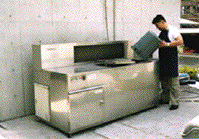 Science & Technology || Search || Back Numbers GARBAGE TO GOLD:
 Composting equipment turns kitchen waste into a valuable agricultural resource. (Photo: Tokyo Gas Co.) Moves are increasingly underway at large-scale corporate and tourist facilities to reprocess kitchen waste for use as feed or fertilizer. A particularly unappealing type of trash, kitchen waste comprises fully one-third of burnable refuse; finding alternative uses for the material greatly reduces local governments' waste-disposal workload. Composting this refuse to sharply reduce its volume and then using it to fertilize organically grown crops is one way to make strides toward a fully recycling society; organizations are coming up with a number of other beneficial ways to use the garbage.
Corporate Composting This office produces 952 metric tons of waste annually, of which 60% is paper, 15% is kitchen waste, and the remainder nonburnables including cans and bottles. The company already recycles over 80% of its paper waste. By focusing its recycling efforts on its kitchen waste beginning last year, it has raised its overall recycling rate from 54% in 1995 to 71% this year. The expense of processing kitchen waste runs to 1.2 million yen (10,000 dollars at 120 yen to the dollar) each month, but according to the person in charge of the program, the company is looking to "provide an example of environmentally friendly behavior." Another 500 tons of kitchen waste is produced annually at a gas company in Minato Ward, Tokyo. Together with a major electronics maker, this firm has developed a waste-processing unit that uses a gas water heater to provide the required heat. In 1995 the company began installing the units in its headquarters and branch offices. The compost produced is shipped to a farm in Gunma Prefecture, where it fertilizes organically grown rice and vegetables. A portion of these crops is returned to the gas company's cafeterias, thus completing a beneficial cycle of resources. A major chain of convenience stores is planning to launch similar recycling activities. An outside firm will collect the boxed lunches, side dishes, and other food items that go unsold at the convenience stores and process them into organic fertilizer. Another cycle of reuse willbe completed when this fertilizer goes to contracted farmers, whose crops go to food-processing companies, which make boxed lunches and the like for sale at the convenience stores. The chain intends to begin this program at its some 400 outlets in the central Tokyo area next fiscal year and go on to extend it nationwide. Trend Spreads to Various Organizations Even schools are getting into the act. Kita Ward in Tokyo installed garbage-processing units in all of its 64 elementary and middle schools last November. The equipment turns school-lunch scraps into fertilizer used on the schools' flowerbeds and fruit trees; some of the compost is also sent to an agricultural research facility in Gunma Prefecture. Some residents of one large housing complex in Yokohama are also using a disposal unit to compost their kitchen waste. The city of Yokohama is advancing a program to reduce the volume of garbage produced in its housing complexes; this complex has been tagged for the pilot waste-composting program as part of these efforts. The kitchen waste (900 grams per day for an average household) is reduced to one-eighth of its volume and used as fertilizer in residents' planters and nearby public garden plots. Only 66 of the 325 households in the complex are currently participating in the program, but the number signing up is on the rise, and the program should eventually be expanded into a complex-wide effort. Toward a Society Based on Resource Recycling After World War II, the era of Japan's booming economic growth saw improvements in incinerator technology that enabled the burning of a mixture of kitchen and other waste. That system, which no longer required separate collection of kitchen and other waste, has largely continued until this day. Ironically, advances in techniques for processing kitchen waste ended up hampering moves toward its reuse. Now, with the increase in composting and reuse of kitchen waste, the handling of the resource has come full circle. Behind the renewed interest in waste recycling lies heightened recognition, among both individuals and companies, of the importance of protecting the environment and creating a society built around resource recycling. Corporations, meanwhile, are faced with an economic facet of the issue now that charges are levied on waste collected from businesses. According to a survey of 3,300 municipalities nationwide carried out by a private organization last fall, fully three-fifths of local governments already charge for garbage collection from businesses, and another one-fifth are currently considering implementing such fees. Corporations looking to cut costs are interested in reducing their waste by recycling as much of it as possible. The number of plants to recycle kitchen waste will certainly continue to climb. As most industrial and other large-scale facilities are generally located in urban areas, however, this will lead to problems concerning the location of and smell produced by these plants; it may also prove more difficult to find enough buyers for the fertilizer produced. But technological improvements in the waste-processing equipment should help to overcome these obstacles. More than anything else, corporations' desire to present an environment-friendly face in this era of increased ecological consciousness should lead to increased recycling of kitchen waste.  Edited by Japan Echo Inc. based on domestic Japanese news sources. Articles
presented here are offered for reference purposes and do not necessarily
represent the policy or views of the Japanese Government.
Edited by Japan Echo Inc. based on domestic Japanese news sources. Articles
presented here are offered for reference purposes and do not necessarily
represent the policy or views of the Japanese Government.
|
